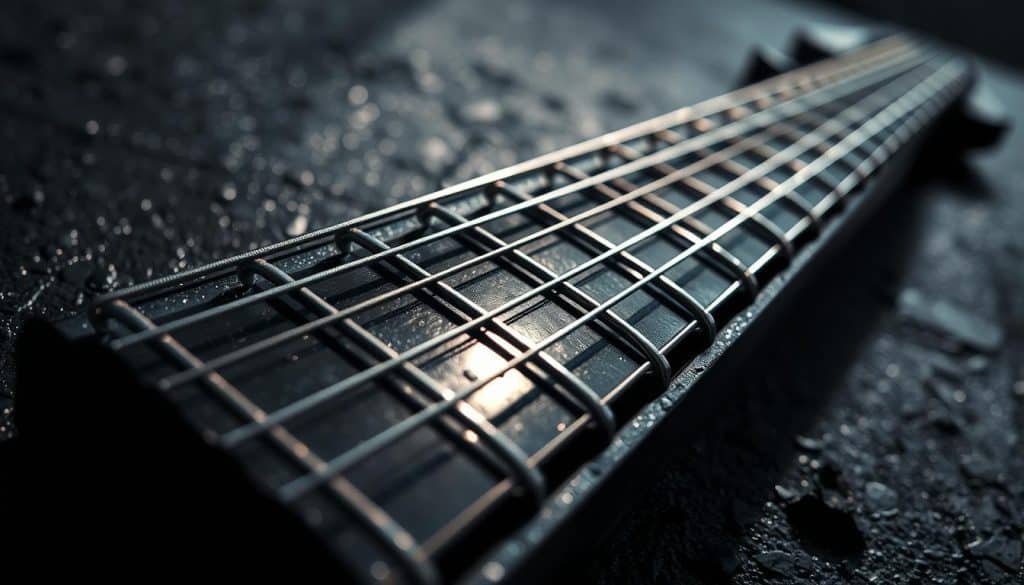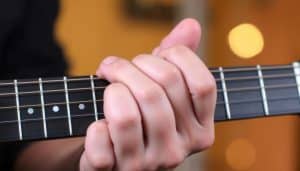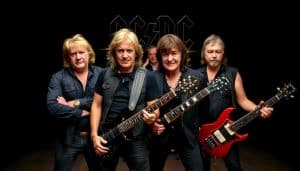Did you know the UAFX ANTI 1992 High Gain Amp mimics the Slipknot metal guitar tone? It serves as a bridge for guitarists to capture the aggressive “scooped” tones of metal and hard rock1. Whether you’re starting out or have years of experience, getting Slipknot’s powerful sound can boost your playing technique and passion.
Slipknot’s guitar work is complex, with intense palm muting and swift hammer ons and pull offs. Learning these techniques can help you master Slipknot’s effects and perfect their unique setup. For instance, “Metal Edge – Metal Rhythm Techniques” by Andy James teaches these very skills, making sophisticated sounds accessible for all2.
This guide dives into the essential equipment, techniques, and secrets to get that unmatched Slipknot metal guitar tone. It’s time to power up your practice and unleash your inner metal beast.
Key Takeaways
- The UAFX ANTI 1992 High Gain Amp captures iconic Slipknot guitar tones1.
- Master essential techniques with the “Metal Edge – Metal Rhythm Techniques” course2.
- Refine your Slipknot guitar setup for the best sound.
- Palm muting, hammer ons, and pull offs are crucial for Slipknot’s signature sound2.
- Discover your metal guitarist within using Slipknot guitar effects.
Understanding Slipknot’s Unique Metal Sound
Slipknot is among the heaviest bands since the late 20th century. Their music’s intensity is unmatched3. They started in 1995 and shook the Nu-Metal world with their nine-member team and fresh sound4. Bands like them changed metal music by adding unique masks and outfits4.
The Evolution of Nu-Metal
Slipknot played a huge role in evolving Nu-Metal. Their albums “Slipknot” and “Iowa” brought many fans to metal4. They explored deep feelings like anger and despair, mixing Nu Metal with Alternative Metal4. Their brave music experiments made a lasting impact on metal4.
The Role of Guitars in Slipknot’s Sound
The guitar sounds set Slipknot apart in metal music. Jim Root and Mick Thomson have special guitars that shape their sound5. They use guitars designed for heavy, bold tones, matching Slipknot’s style5. The song “Duality” shows how guitar distortion and techniques build up energy, showcasing their skill in metal music.
Essential Gear for Achieving Slipknot’s Tone
Slipknot’s sound in metal music is unique because of the gear they choose. If you want to sound like them, knowing which guitar equipment they prefer is key. This gear helps create their intense, aggressive tone.
Guitars: Models and Specifications
Jim Root, a key Slipknot guitarist, loves a few specific models. He uses the Fender Jim Root Telecaster, Fender Jim Root Jazzmaster, and Charvel Jim Root Signature Pro-Mod San Dimas Style 1, all with EMG 81/60 active pickups6. Mick Thomson has a different taste, opting for ESP guitars. His favorites include the ESP M-II Custom, ESP E-II Arrow, and ESP Custom Shop Eclipse, all with Seymour Duncan Blackout pickups7. These guitars are crucial for achieving the Slipknot sound — aggressive and punchy.
Amplifiers: Power and Settings
Amplifiers are key for Slipknot’s signature sound. Jim Root’s go-to amps are the Orange Rockerverb 100 MKIII and Orange PPC412 4×12 Cabinet6. These amps help create a powerful, balanced tone. Mick Thomson goes for the Rivera KR7, a 120-watt head, for his heavy riffs8.
Setting up Slipknot’s amp tones involves a lot of gain and bass. Start the gain around 8 for solid state amps. Set your bass at 8, too. Then, tweak the mids and treble to find the perfect sound mix7.
Effects Pedals and Their Importance
Effects pedals shape Slipknot’s tone by fixing feedback and sustain issues. Jim Root’s pedalboard has many types, like the Boss NS-2 Noise Suppressor and MXR Carbon Copy Delay6. These help keep his sound clear and deep. Mick Thomson uses fewer pedals, focusing on distortion and compression for a clean, powerful tone8. The right pedals are crucial for replicating Slipknot’s sound.
| Guitarist | Guitars | Amplifiers | Pedals |
|---|---|---|---|
| Jim Root | Fender Jim Root Telecaster, Fender Jim Root Jazzmaster, Charvel Jim Root Signature Pro-Mod San Dimas Style 1 | Orange Rockerverb 100 MKIII, Orange PPC412 4×12 Cabinet | Boss NS-2, MXR Auto Q Wah, Maxon AF-9, MXR Carbon Copy, EH Holy Grail, EH Micro POG |
| Mick Thomson | ESP M-II Custom, ESP E-II Arrow, ESP Custom Shop Eclipse | Rivera KR7 head at 120 watts, Orange amps7 | High-output Seymour Duncan Blackout pickups, Distortion and Compression Pedals |
Exploring Slipknot’s Guitar Effects
Slipknot’s sound is unique thanks to their guitar pedals. These pedals give their music an aggressive and dynamic tone. To sound like them, learn about overdrive, distortion, reverb, and delay.
Overdrive and Distortion
Slipknot’s heavy music relies on overdrive and distortion pedals. Jim Root and Mick Thomson use these to get their powerful tones. Try pedals like the EarthQuaker Devices Plumes and the Death By Audio Fuzz War9. To capture Slipknot’s sound, get to know Slipknot guitar pedals. Experiment with overdrive and distortion.
Reverb and Delay
Reverb and delay add depth to Slipknot’s aggressive music. Reverb creates a bigger sound. Delay adds complexity to their guitar playing. Using reverb and delay makes your metal sound fuller and more atmospheric.
Using these effects, you can get closer to Slipknot’s sound. This also lets you create your own style. Mixing distortion with reverb and delay can lead to new sounds.
Mastering Palm Muting Techniques
To play metal rhythm guitar well, you must learn palm muting. It gives the music a tight, percussive sound. This skill is key to the powerful feel of metal tunes.
The Importance of Palm Muting in Metal
Palm muting is vital for metal rhythm guitarists. First, it makes a tight, muted sound needed for metal riffs. This sound is a big part of what makes the genre unique10. Palm muting creates a heavy, percussive effect in famous metal songs11. It also adds depth to the music and lets players control how long their notes last. This makes their playing more dynamic and interesting.
Practicing with backing tracks is a smart way to get better at palm muting. It also helps you keep time and improve your rhythm10. Working with these tracks often makes your musicality and precision better. These are key for good palm muting.
Exercises to Enhance Your Palm Muting
To get better at palm muting, try specific exercises. Here are some to start with:
- Power Chord Palm Muting: Work on muting power chords, a big part of metal music. Aim for a steady, muted sound when you strum11.
- Gallop Strumming: This rhythm technique is common in metal. It helps you get more precise and faster at palm muting. Start slow, then speed up11.
- Alternate Picking with Palm Muting: Mix alternate picking with your palm muting drills. This will help you get a precise, tight sound that metal rhythm guitar needs10.
Stick with these exercises and you’ll improve a lot at palm muting. Listening to metal masters like Andy James is also helpful. They show the value of palm muting in metal and share tips on getting it right10.
Accenting and Picking Exercises for Metal Guitar
Improving your metal guitar skills takes mastering accenting techniques and picking drills. These skills are key for the strong, rhythmic sounds of metal music. To get better, you should try different metal guitar exercises.
Working on accenting means you focus on making some notes louder to sound more powerful. A good tip is to play louder on the first and third beats with eighth notes. This makes the music feel more intense.
To get better, try out styles like Thrash Metal, Death Metal, and Doom Metal. Each one has its own rhythm and ways to emphasize notes12. For example, Thrash Metal uses fast and forceful picking.
Guitar picking can improve with structured practice. Video lessons that show different angles and interactive features, like looping and zoom, help a lot13. “Metal Edge – Metal Rhythm Techniques” by Andy James is a course that helps all levels of players2.
Also, work on precise picking drills. Start with alternate picking to get faster and more accurate. Add palm muting exercises to keep your timing steady.
Here’s a way to organize your practice:
- Accenting Downstrokes: Focus on accenting the first and third beats of each measure.
- Alternate Picking: Practice with a metronome, gradually increasing the speed.
- Palm Muting: Apply pressure with the side of your palm to mute strings and create a chugging sound.
- Combination Exercises: Mix accents, alternate picking, and palm muting to create dynamic riffs.
Adding these exercises to your routine will not only make your accenting better but also your picking control. This will make your playing powerful, like the metal guitar legends1213.
Incorporating Hammer Ons and Pull Offs
Mastering hammer ons and pull offs is key for metal guitarists. They speed up your riffs and make your playing smoother. This style is exactly what makes Slipknot’s music stand out.
Adding Fluidity to Your Playing
Fluid guitar playing relies on using hammer ons and pull offs well. Bands like Led Zeppelin and Deep Purple used these techniques to change guitar sounds. Guitarists gain a wider range and smoother note changes by using these methods14.
Andy James highlights these techniques for fluid playing. They’re crucial for the fast riffs in metal music15.
Executing Hammer Ons and Pull Offs Correctly
To do hammer ons and pull offs right, focus on finger strength and accuracy. Start with scales and simple riffs to build muscle memory. It’s not just about speed but making each note clear.
Bands like Judas Priest and Iron Maiden have used these detailed techniques since the 1970s. For example, to do a hammer on, you hit a higher fret without plucking again. Pull offs involve letting a lower note sound by lifting your finger off a fret.
Practicing these techniques regularly can help you play fast riffs like Slipknot. It’s a way to manage quick changes, vital for intense metal music.
| Technique | Description | Impact on Playing |
|---|---|---|
| Hammer Ons | Pressing down on a second note without picking again. | Increases fluidity and speed. |
| Pull Offs | Releasing a note to let a lower note ring. | Creates clear, fast note transitions. |
Perfecting Left Hand Muting
Getting good at left hand muting is key for a clean sound in metal guitar. It stops unwanted noise and makes your playing clearer. This is important in bands like Slipknot.
You mute by resting your fingers lightly on the strings. This is great for getting a heavy sound in Drop B tuning, like Slipknot uses11.
To get better, try watching slow-motion videos. They show the right way to hold your hand. This makes practicing parts of a riff over and over easier until you get it right16.
“It’s all about developing muscle memory,” says Mick Thomson of Slipknot. “Muting guitar strings properly is crucial for achieving the tight, percussive sounds we aim for in our music.”
Practice with jam tracks in .mp3 format to improve timing. They’re great for working on your left hand muting16.
Video Tab Sync helps you follow video lessons and read tabs at the same time. This makes learning to match your moves to the right notes easier16.
Trying different tunings also helps. For example, Drop C# tuning can give you the heavy metal sound. Practice with a rhythm track to improve your music skills10.
Remember to focus on clear notes without noise. This is the heart of high-quality metal riffs. Careful practice will make your metal sound polished like Slipknot’s songs.
In summary, mix video lessons, slo-motion, Video Tab Sync, and various tunings with practice tracks. This will vastly improve your left hand muting. Your sound will be as tight and precise as the pros in the metal world.
Slipknot Guitar Rig Setup
Diving into Slipknot’s guitar rig setup boosts your tone to the next level. We’ll look at Jim Root’s and Mick Thomson’s gear. This gives you a clear picture of what makes their sound unique.
Complete Breakdown of Jim Root’s Rig
Jim Root’s setup is a mix of different instruments, amps, and pedals. It matches Slipknot’s intense sound. He started with a Jackson DR-3 Dinky and used pedals like Digitech WH-1 Whammy17.
A key part of his rig is the Fender Jim Root Telecaster with EMG pickups18. His mix of Mesa/Boogie and Orange amps creates his signature sound.
Root’s pedal board features brands like Boss and MXR18. He also relies on multiple amps for his live sound. The Audio-Technica AEW-R5200 ensures he stays connected on stage18.
For big tours, Root adds new effects to his setup17. His Jazzmaster and Bogner Uberschall amp were key during “We Are Not Your Kind”.
An In-Depth Look at Mick Thomson’s Setup
Mick Thomson’s rig is key to Slipknot’s sound. His Ibanez guitars with Seymour Duncan pickups are central. They ensure a loud, aggressive tone.
His amps, like the Peavey 6505+ and Rivera KR7, offer a massive sound. Thomson’s pedalboard, filled with effects, shapes his unique sound.
To master Slipknot’s tone, studying Jim Root and Mick Thomson’s gear is essential. Their setups reveal how to achieve that signature Slipknot sound.
Getting the Slipknot Guitar Settings Right
Getting the Slipknot guitar settings right means mixing the correct metal amp setups with precise guitar pedal tweaks. To create Slipknot’s signature heavy sound, you need to carefully choose and adjust your gear.
Ideal Amp and Pedal Settings
To sound like Slipknot, try the Recto amp with Equalizer pedals. This setup is a top pick in the Deplike app19. The Tangerine amp and Equalizer pedal are also great for that distinct Slipknot vibe19.
The Deplike app gives you studio-quality effects. It has 15 amps and cabinets, plus 21 guitar effects pedals. This means tons of sound options to play with19. For a Slipknot-style deep bass, bassists often go for the Recto amp and Equalizer pedal19.
Tweaking Your Guitar Settings
Enhancing your Slipknot guitar settings can include using Jim Root’s gear. His setup features a Fender Jim Root Telecaster and Orange Rockerverb 100 MKIII amp, plus an Orange PPC412 4×12 Cabinet6. He also uses EMG active pickups, the Boss NS-2 Noise Suppressor, and MXR Auto Q Wah pedals for his intense sound6.
Try different pedal mixes to get true Slipknot tones. Playing with the gain and EQ on your amp and pedals will get you closer to the sound you want. Deplike, paired with DAWs like Cubase, Logic Pro, and Garageband, lets guitarists record with top-notch quality19.
For more on Slipknot’s background and sound, visit the detailed Slipknot Wikipedia page. Learn about their journey to stardom and their special take on heavy metal!
Choosing the Right Strings for Slipknot’s Tone
To get the Slipknot guitar sound, it’s crucial to pick the right strings. The thickness and material of strings are key for that heavy sound. Plus, knowing which brands the band members use helps you choose well.
Gauge and Material Considerations
Slipknot likes thick metal string gauges for a tight and powerful sound. The string’s material matters too. Nickel-plated steel gives a bright tone and pure nickel has a warmer vibe. Try different guitar string materials to see what fits your style best.
Jim Root goes for heavy gauge strings for a richer tone. Mick Thomson looks for strings that give a precise sound. They both use humbuckers, which pair well with certain strings. This boosts your Slipknot tone20.

String Brands Used by Slipknot
Jim Root and Mick Thomson each have favorite string brands. Root goes for Ernie Ball because they’re reliable. Thomson chooses D’Addario for their quality and endurance. Their string choices help keep their sound powerful yet clear21.
For more tips on rock and metal guitar, including Slipknot’s technique, check out this guide.
Techniques to Enhance Your Slipknot Guitar Sound
To get that Slipknot guitar tone, start with the right equipment and metal playing methods. The Deplike app offers four special settings for this sound. You can try a mix with a Recto amp and Equalizer pedal, or a Tangerine amp with Equalizer. This helps19improve your guitar’s sound.
Looking at Slipknot guitarists’ setups can also help. Jim Root loves using high-gain Orange amps and his custom Fender guitars with EMG pickups8. Mick Thomson’s setup includes a Jackson super Strat and Seymour Duncan pickups, along with a Rivera amp8. Adding these to your gear can really boost your sound.
Mastering certain metal techniques is key to playing Slipknot songs. You should learn riffs, tremolo picking, palm muting, and using hammer-ons and pull-offs. Using fret muting and pedals for delays and fuzz adds more to your sound.
Try more amp and cabinet types in the Deplike app to enhance your Slipknot tone. It offers models like the Tangerine Rocker 100 and Dual Recto19. The app’s 21 guitar effects pedals are also vital for achieving Slipknot’s powerful tone19.
If you’re new, start with easier Slipknot songs. Check out this list of materials for helpful tips and tricks to improve your guitar sound.
Slipknot Metal Guitar Tone Secrets
The secret behind Slipknot’s signature guitar tone is a mix of studio and live sound magic. Their music stands out because of the production quality. This quality enhances both studio recordings and live shows.
The Magic of Slipknot’s Production
Recording metal needs precise skills and knowledge of guitar studio techniques. Slipknot gets their heavy sound with tactics like using a Line6 head and a Marshall cabinet with an SM57 mic for recording22. Jim Root shapes the Slipknot guitar sound with EMG pickups, especially the EMG Jim Root Daemonum Humbucker6. They also layer guitar tracks to make the sound fuller22.
Reproducing the Studio Sound Live
Slipknot matches their studio sound in concerts with the right gear and techniques. Jim Root plays a Fender Jim Root Telecaster, Jazzmaster, and a Charvel Signature model6. His amps, the Orange Rockerverb 100 MKIII and Orange Cabinet, deliver Slipknot’s powerful live sound6. The favorite Slipknot guitar preset among fans includes a Recto amp and an Equalizer pedal19.
Keeping Slipknot’s sound great live means adjusting mic places and settings22. You need the right amp settings for the perfect crunch and filters to control bass. Using pedals like the Boss NS-2 and Electro-Harmonix Holy Grail Reverb is key for the Slipknot live sound6.
To sound like Slipknot, mix these studio and live techniques. This advice helps whether you’re recording or playing live. It’s how you can sound like the iconic metal band and connect with their fans.
Benefits of Watching Professional Performances
Watching pro shows is key for guitar learners. Seeing live acts, like Slipknot, teaches you about guitar skills and stage presence.
Learning from Live and Recorded Performances
It’s not just about watching guitarists play. It’s about seeing how they handle the stage. Slipknot’s energetic performances are a perfect study in stage dynamics. From them, you learn to move well on stage and avoid just standing still23.
Recording your own shows is also smart. It lets you see where you need to get better23.
Analysis of Technique and Sound
Studying guitar sounds at metal concerts is useful. Slipknot has a special sound, different from bands like Bring Me The Horizon. Their album, “We Are Not Your Kind,” shows their high level of skill24. Watching them helps you learn these unique techniques for your own music.
By watching pros, you learn more than just music. You see how to move and interact with audiences, like Slipknot does. Mimicking their movements and connection with fans can make your performances better23. This helps improve both your guitar skills and how you perform on stage.
Customizing Your Slipknot Tone with UAFX App
The UAFX app is a must-have for guitarists who love Slipknot’s unique guitar sound. The app’s UAFX ANTI 1992 High Gain Amp gives you the same heavy tone that bands like Slipknot and In Flames use25. It’s perfect for getting those modern metal, aggressive “scooped” sounds25.
Customizing your guitar tone is easy with the UAFX mobile app. It features six mic and speaker combos that mirror the ones used in iconic metal amps from the 90s26. You can use presets from famous guitarists or make and save your own tones26.
Presets and Customization Options
With the app, you get presets created by pro guitarists, letting you mimic their sounds. You can fine-tune your tone by adjusting hidden controls and more with the UAFX app25. This makes shaping your sound simple.
Also, the ANTI 1992 High Gain Amp has a built-in noise gate and overdrive. This lets you achieve clean, studio-quality metal tones that sound just like Slipknot26.
Troubleshooting Common Issues
Sometimes gear can be tricky, but the UAFX app makes fixing problems easy. You can correct noise issues and find the best mic and speaker setup for a great sound. The app’s advanced editing lets you fix problems without stress26.
The amp mimics a powerful 120-watt tube amp and has six mic/speaker setups from famous metal and rock albums25. It captures the essence of Slipknot’s sound, giving you control over it through your phone.
Here’s a closer look at some of the app’s main features and what they do:
| Feature | Description | Benefit |
|---|---|---|
| Six Mic/Speaker Pairings | Includes UK V30, CA V30, White 75, and 3 bonus cabs | Captures legendary metal sounds25 |
| Built-in Noise Gates | TS-style overdrive and preamp boost | Ensures tight, polished tones26 |
| Professional Presets | Access tones from pro guitarists | Replicate signature sounds26 |
| Deep Editing | Customize hidden controls and boosts | Fine-tuning for personalized tones25 |
Getting Slipknot’s iconic tone is easy with the UAFX app’s presets. Whether starting from scratch or fixing pedal issues, this app and amp can elevate your metal riffs.
Conclusion
Exploring Slipknot’s metal guitar secrets has shown how precision, gear, and knowing their style matter. To master Slipknot’s sound, blend special techniques with the right equipment. Essential settings for a nu-metal sound include gain at 6 and bass at 527. Picking the best amps, like Marshall’s JCM series, can also uplift your tone27.
Key techniques like palm muting and pull-offs lay the foundation for Slipknot’s intense sound. Using these methods with proper amp settings gets you closer to their signature vibe. For a hard rock sound, tweak your amp to presence at 5 and bass at 727.
Regular practice and tweaking settings helps in nailing the metal guitar tone. It takes patience and commitment to capture Slipknot’s powerful sound. Whether jamming in your room or recording professionally, chasing the Slipknot guitar dream is an exciting path. So, keep striving and make your guitar riffs thunder!






